
Xerochrysum bracteatum, commonly known as the golden everlasting or strawflower, is a flowering plant in the family Asteraceae native to Australia. Described by Étienne Pierre Ventenat in 1803, it was known as Helichrysum bracteatum for many years before being transferred to a new genus Xerochrysum in 1990. It is an annual up to 1 m (3.3 ft) tall with green or grey leafy foliage. Golden yellow or white flower heads are produced from spring to autumn; their distinctive feature is the papery bracts that resemble petals. The species is widespread, growing in a variety of habitats across the country, from rainforest margins to deserts and subalpine areas. The golden everlasting serves as food for various larvae of lepidopterans, and adult butterflies, hoverflies, native bees, small beetles, and grasshoppers visit the flower heads.
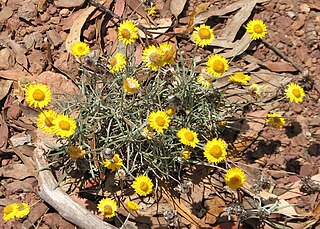
Leucochrysum is a genus of flowering plants in the tribe Gnaphalieae within the family Asteraceae, endemic to Australia.

Chrysocephalum semipapposum, commonly known as clustered everlasting is a perennial shrub native to Australia. Clustered everlasting belongs to the family Asteraceae. C. semipapposum produces terminal flowers heads in clusters, mainly between spring and early summer with silver-grey appearing stems and branches. It grows up to 40 cm high and 60 cm high, although there have been some varieties which can grow up to 1 m. C. semipapposum is often confused with Chrysocephalum apiculatum or 'yellow buttons', due to their similar appearances. C. semipapposum has 4 different subspecies, however they lack distinctive qualities and are often hard to identify. C. semipapposum is endemic to Australia and can be found in multiple states, most notably within Victoria. The plant is found in a variety of habitats including dry rocky regions. Clustered everlasting often grows sparsely and is rarely found in abundance and can be mistaken for a weed. Clustered everlasting has many uses, including as a source of nectar for butterflies, cut flowers or as an addition to a garden.

Coronidium elatum, commonly known as the white paper daisy or tall everlasting, is a perennial herbaceous shrub in the family Asteraceae found in open forests in eastern Australia. A woody shrub 0.6 to 2 m tall, it has white flowers which appear in spring. It was known as Helichrysum elatum for many years until it was finally reviewed in 2008.
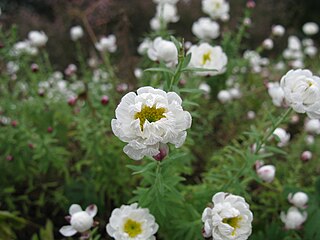
Rhodanthe anthemoides, commonly known as chamomile sunray, is a flowering plant in the family Asteraceae. It is a small, perennial shrub with greyish-green leaves, white papery flowers, yellow centre and is endemic to Australia.

Leucochrysum albicans, commonly known as hoary sunray, is a flowering plant in the family Asteraceae. It is a small perennial with grey leaves, white or yellow flower-heads and is endemic to Australia.
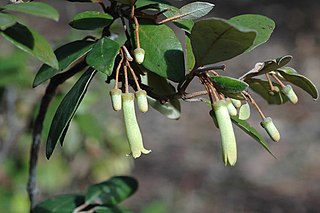
Correa lawrenceana var. glandulifera, commonly known as the mountain correa, is a variety of Correa lawrenceana and is endemic to eastern Australia. It is a shrub or small tree with egg-shaped leaves and greenish yellow flowers arranged singly or in groups of up to five with woolly hairs on the outside.

Correa lawrenceana var. latrobeana is a variety of Correa lawrenceana that is endemic to south-eastern Australia. It is a shrub or small tree with elliptical to egg-shaped leaves and cylindrical, greenish-yellow or reddish-mauve flowers arranged singly or in groups of up to seven in leaf axils or on the ends of branchlets.
Correa lawrenceana var. macrocalyx is a variety of Correa lawrenceana and is endemic to New South Wales. It is a shrub with leathery, egg-shaped to broadly egg-shaped leaves, and cylindrical, greenish yellow flowers arranged in leaf axils or on the ends of short branchlets.

Argentipallium niveum is a species of flowering plant within the genus, Argentipallium, in the daisy family (Asteraceae). It is endemic to Western Australia.
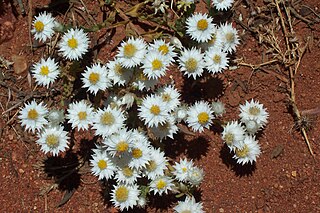
Rhodanthe floribunda, commonly known as common white sunray, is a flowering, herbaceous plant in the family Asteraceae. It is a small, upright or decumbent plant with white flowers, yellow florets and is endemic to Australia.

Helichrysum calvertianum is a species of flowering plant in the family Asteraceae. It is a small subshrub with small crowded leaves and single white daisy-like flowers. It is endemic to the Southern Highlands in New South Wales.

Coronidium rupicola, commonly known as the yellow button, is a flowering plant in the family Asteraceae. It is a small, upright, perennial shrub with yellow flowers borne on a single stem and is endemic to Queensland, Australia.

Argentipallium obtusifolium, commonly known as blunt everlasting, is a species of flowering plant in the family Asteraceae. It is a small, multi-stemmed perennial with white flowers, dark green leaves and is endemic to Australia.

Rhodanthe chlorocephala commonly known as pink and white everlasting, is a flowering plant in the family Asteraceae. It is a small, tufted plant with blue-green leaves, white, pink or yellow flowers and grows in Western Australia and South Australia.

Rhodanthe humboltiana, commonly known as the golden cluster everlasting, is a flowering annual in the family Asteraceae. It is a small, upright, branching plant with yellow flowers, and is endemic to Western Australia.
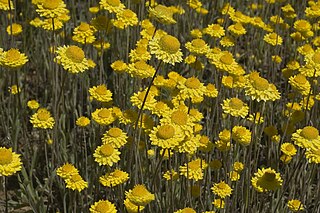
Leucochrysum molle, commonly known as hoary sunray, is a flowering plant in the family Asteraceae. It is a small, clumping perennial with grey leaves, yellow flower-heads and is endemic to Australia.

Hyalosperma praecox commonly known as fine-leaf sunray, is a flowering plant in the family Asteraceae. It is an upright, annual herb with stems branching from the base and yellow or white flowers and grows in New South Wales and Victoria.

Ammobium craspedioides, commonly known as Yass daisy, is a species of perennial herb in the daisy family Asteraceae. It has slender stems, grey leaves and heads of yellow flowers and is endemic to New South Wales.

Leucochrysum alpinum, commonly known as alpine sunray, is a flowering plant in the family Asteraceae. It is a small, clumping perennial with grey leaves, white flower-heads and is endemic to Australia.


















